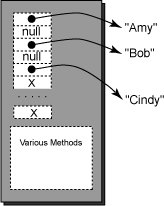Answer:
The equals(Object) method could be made case insensitive.
Another good modification of the program would be to allow the user to put new entries into the list.
The equals(Object) method could be made case insensitive.
Another good modification of the program would be to allow the user to put new entries into the list.
null as an Element
An ArrayList element can be an object reference or the value null.
When a cell contains null, the cell is not considered to be empty.
The picture shows empty cells with an "X" and cells that contain a null with null.

import java.util.* ;
public class ArrayListEgFive
{
public static void main ( String[] args)
{
// Create an ArrayList that holds references to String
ArrayList<String> names = new ArrayList<String>();
// Add three Object references and two nulls
names.add("Amy");
names.add(null);
names.add("Bob");
names.add(null);
names.add("Cindy");
System.out.println("size: " + names.size() );
// Access and print out the Objects
for ( int j=0; j<names.size(); j++ )
System.out.println("element " + j + ": " + names.get(j) );
}
}
The program prints out:
size: 5 element 0: Amy element 1: null element 2: Bob element 3: null element 4: Cindy
The cells that contain null are not empty,
and contribute to the size of the list.
It is confusing when nulls are elements of some cells.
Don't write your programs to do this unless there is a good reason.
If you wish to remove Cindy from the ArrayList, should you set that cell to null?
names.set( 4, null )